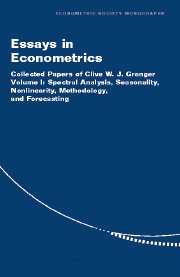Book contents
- Frontmatter
- Contents
- Acknowledgments
- List of Contributors
- Introduction
- 1 The ET Interview: Professor Clive Granger
- PART ONE SPECTRAL ANALYSIS
- PART TWO SEASONALITY
- PART THREE NONLINEARITY
- PART FOUR METHODOLOGY
- PART FIVE FORECASTING
- 17 Estimating the Probability of Flooding on a Tidal River
- 18 Prediction with a Generalized Cost of Error Function
- 19 Some Comments on the Evaluation of Economic Forecasts
- 20 The Combination of Forecasts
- 21 Invited Review: Combining Forecasts – Twenty Years Later
- 22 The Combination of Forecasts Using Changing Weights
- 23 Forecasting Transformed Series
- 24 Forecasting White Noise
- 25 Can We Improve the Perceived Quality of Economic Forecasts?
- 26 Short-Run Forecasts of Electricity Loads and Peaks
- Index
26 - Short-Run Forecasts of Electricity Loads and Peaks
Published online by Cambridge University Press: 06 July 2010
- Frontmatter
- Contents
- Acknowledgments
- List of Contributors
- Introduction
- 1 The ET Interview: Professor Clive Granger
- PART ONE SPECTRAL ANALYSIS
- PART TWO SEASONALITY
- PART THREE NONLINEARITY
- PART FOUR METHODOLOGY
- PART FIVE FORECASTING
- 17 Estimating the Probability of Flooding on a Tidal River
- 18 Prediction with a Generalized Cost of Error Function
- 19 Some Comments on the Evaluation of Economic Forecasts
- 20 The Combination of Forecasts
- 21 Invited Review: Combining Forecasts – Twenty Years Later
- 22 The Combination of Forecasts Using Changing Weights
- 23 Forecasting Transformed Series
- 24 Forecasting White Noise
- 25 Can We Improve the Perceived Quality of Economic Forecasts?
- 26 Short-Run Forecasts of Electricity Loads and Peaks
- Index
Summary
Abstract
This paper reports on the design and implementation of a short-run forecasting model of hourly system loads and an evaluation of the forecast performance. The model was applied to historical data for the Puget Sound Power and Light Company, who did a comparative evaluation of various approaches to forecasting hourly loads, for two years in a row. The results of that evaluation are also presented here. The approach is a multiple regression model, one for each hour of the day (with weekends modelled separately), with a dynamic error structure as well as adaptive adjustments to correct for forecast errors of previous hours. The results show that it has performed extremely well in tightly controlled experiments against a wide range of alternative models. Even when the participants were allowed to revise their models after the first year, many of their models were still unable to equal the performance of the authors' models. © 1997 Elsevier Science B.V.
Keywords: comparative methods; energy forecasting; forecasting competitions; regression methods; exponential smoothing.
INTRODUCTION
Electric utilities have always forecast the hourly system loads as well as peak loads to schedule generator maintenance and to choose an optimal mix of on-line capacity. As some facilities are less efficient than others, it is natural to bring them into service only during hours when the load is predicted to be high. Nowadays however, the need for accurate hourly load forecasts is even greater.
- Type
- Chapter
- Information
- Essays in EconometricsCollected Papers of Clive W. J. Granger, pp. 497 - 516Publisher: Cambridge University PressPrint publication year: 2001
- 3
- Cited by



